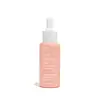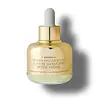What's inside
What's inside
 Key Ingredients
Key Ingredients

 Benefits
Benefits

 Concerns
Concerns

 Ingredients Side-by-side
Ingredients Side-by-side

Aloe Barbadensis Leaf Juice
Skin ConditioningWater
Skin ConditioningPropanediol
SolventPanthenol
Skin ConditioningSodium Lactate
BufferingGluconolactone
Skin ConditioningSodium Hyaluronate
HumectantHydrolyzed Sodium Hyaluronate
Skin ConditioningSodium Acetylated Hyaluronate
HumectantSodium Hyaluronate Crosspolymer
HumectantAcetyl Hexapeptide-8
HumectantSodium PCA
HumectantDiutan Gum
Carrageenan
Pentylene Glycol
Skin ConditioningCaprylyl Glycol
EmollientSodium Benzoate
MaskingPantolactone
HumectantEthylhexylglycerin
Skin ConditioningGlucose
HumectantCalcium Gluconate
HumectantSodium Hydroxide
BufferingLactic Acid
BufferingAloe Barbadensis Leaf Juice, Water, Propanediol, Panthenol, Sodium Lactate, Gluconolactone, Sodium Hyaluronate, Hydrolyzed Sodium Hyaluronate, Sodium Acetylated Hyaluronate, Sodium Hyaluronate Crosspolymer, Acetyl Hexapeptide-8, Sodium PCA, Diutan Gum, Carrageenan, Pentylene Glycol, Caprylyl Glycol, Sodium Benzoate, Pantolactone, Ethylhexylglycerin, Glucose, Calcium Gluconate, Sodium Hydroxide, Lactic Acid
Water
Skin ConditioningAlcohol Denat.
AntimicrobialPentylene Glycol
Skin ConditioningGlycerin
HumectantPolyglyceryl-5 Laurate
EmulsifyingPropanediol
SolventAlpha-Isomethyl Ionone
PerfumingAvena Sativa Kernel Extract
AbrasiveBenzyl Alcohol
PerfumingBenzyl Salicylate
PerfumingCaprylyl Glycol
EmollientCI 77891
Cosmetic ColorantCitral
PerfumingCopper Lysinate/Prolinate
Skin ConditioningCrocus Sativus Stigma Extract
Glyceryl Acrylate/Acrylic Acid Copolymer
HumectantHexapeptide-11
Skin ConditioningHydrolyzed Sodium Hyaluronate
Skin ConditioningLactic Acid
BufferingLimonene
PerfumingLinalool
PerfumingLonicera Caprifolium Flower Extract
PerfumingLonicera Japonica Flower Extract
Skin ConditioningMethylglucoside Phosphate
Skin ConditioningMica
Cosmetic ColorantParfum
MaskingPhenoxyethanol
PreservativePolyacrylate Crosspolymer-6
Emulsion StabilisingSodium Benzoate
MaskingSodium Carboxymethyl Beta-Glucan
CleansingSodium Hyaluronate
HumectantTamarindus Indica Seed Gum
Emulsion StabilisingXanthan Gum
EmulsifyingWater, Alcohol Denat., Pentylene Glycol, Glycerin, Polyglyceryl-5 Laurate, Propanediol, Alpha-Isomethyl Ionone, Avena Sativa Kernel Extract, Benzyl Alcohol, Benzyl Salicylate, Caprylyl Glycol, CI 77891, Citral, Copper Lysinate/Prolinate, Crocus Sativus Stigma Extract, Glyceryl Acrylate/Acrylic Acid Copolymer, Hexapeptide-11, Hydrolyzed Sodium Hyaluronate, Lactic Acid, Limonene, Linalool, Lonicera Caprifolium Flower Extract, Lonicera Japonica Flower Extract, Methylglucoside Phosphate, Mica, Parfum, Phenoxyethanol, Polyacrylate Crosspolymer-6, Sodium Benzoate, Sodium Carboxymethyl Beta-Glucan, Sodium Hyaluronate, Tamarindus Indica Seed Gum, Xanthan Gum
 Reviews
Reviews

Ingredients Explained
These ingredients are found in both products.
Ingredients higher up in an ingredient list are typically present in a larger amount.
Caprylyl Glycol is a humectant and emollient, meaning it attracts and preserves moisture.
It is a common ingredient in many products, especially those designed to hydrate skin. The primary benefits are retaining moisture, skin softening, and promoting a healthy skin barrier.
Though Caprylyl Glycol is an alcohol derived from fatty acids, it is not the kind that can dry out skin.
This ingredient is also used as a preservative to extend the life of products. It has slight antimicrobial properties.
Learn more about Caprylyl GlycolThis ingredient is created by putting sodium hyaluronate through hydrolysis.
You might know this as 'mini' or 'ultra low-molecular weight' hyaluronic acid. The small molecule size means it is able to travel deeper in the skin.
According to studies, low molecular-weight hyaluronic acid can:
One study from 2011 found ultra-low weight HA to show pro-inflammatory properties. Another study from 2022 found it to downregulate UV-B induced inflammation.
Hydrolysis is a process of changing a molecule using water or enzymes.
This ingredient is water-soluble.
Learn more about Hydrolyzed Sodium HyaluronateLactic Acid is another well-loved alpha hydroxy acid (AHA). It is gentler than glycolic acid but still highly effective.
Its main role is to exfoliate the surface of the skin by loosening the “glue” that holds dead skin cells together. Shedding those old cells leads to smoother, softer, and more even-toned skin.
Because lactic acid molecules are larger than glycolic acid, they don’t penetrate as deeply. This means they’re less likely to sting or irritate, making it a great choice for beginners or those with sensitive skin.
Like glycolic acid, it can:
Lactic acid also acts as a humectant (like hyaluronic acid). It can draw water into the skin to improve hydration and also plays a role in the skin's natural moisturizing factor (NMF) in the form of sodium lactate.
Studies show it can boost ceramide production to strengthen the skin barrier and even help balance the skin’s microbiome.
To get results, choose products with a pH between 3-4.
Lower strengths (5-12%) focus on surface exfoliation; higher strengths (12% and up) can reach deeper in the dermis (deeper, supportive layer) to improve skin texture and firmness over time.
Though it was originally derived from milk, most modern lactic acid used in skincare is vegan. It is made through non-dairy fermentation to create a bio-identical and stable form suitable for all formulations.
When lactic acid shows up near the end of an ingredient list, it usually means the brand added just a tiny amount to adjust the product’s pH.
Legend has it that Cleopatra used to bathe in sour milk to help reduce wrinkles.
Lactic acid is truly a gentle multitasker: it exfoliates, hydrates, strengthens, and brightens. It's a great ingredient for giving your skin a smooth, glowing, and healthy look without the harshness of stronger acids.
Read more about some other popular AHA's here:
Learn more about Lactic AcidPentylene glycol is typically used within a product to thicken it. It also adds a smooth, soft, and moisturizing feel to the product. It is naturally found in plants such as sugar beets.
The hydrophilic trait of Pentylene Glycol makes it a humectant. As a humectant, Pentylene Glycol helps draw moisture from the air to your skin. This can help keep your skin hydrated.
This property also makes Pentylene Glycol a great texture enhancer. It can also help thicken or stabilize a product.
Pentylene Glycol also acts as a mild preservative and helps to keep a product microbe-free.
Some people may experience mild eye and skin irritation from Pentylene Glycol. We always recommend speaking with a professional about using this ingredient in your routine.
Pentylene Glycol has a low molecular weight and is part of the 1,2-glycol family.
Learn more about Pentylene GlycolPropanediol is an all-star ingredient. It softens, hydrates, and smooths the skin.
It’s often used to:
Propanediol is not likely to cause sensitivity and considered safe to use. It is derived from corn or petroleum with a clear color and no scent.
Learn more about PropanediolSodium Benzoate is a preservative. It's used in both cosmetic and food products to inhibit the growth of mold and bacteria. It is typically produced synthetically.
Both the US FDA and EU Health Committee have approved the use of sodium benzoate. In the US, levels of 0.1% (of the total product) are allowed.
Sodium benzoate works as a preservative by inhibiting the growth of bacteria inside of cells. It prevents the cell from fermenting a type of sugar using an enzyme called phosphofructokinase.
It is the salt of benzoic acid. Foods containing sodium benzoate include soda, salad dressings, condiments, fruit juices, wines, and snack foods.
Studies for using ascorbic acid and sodium benzoate in cosmetics are lacking, especially in skincare routines with multiple steps.
We always recommend speaking with a professional, such as a dermatologist, if you have any concerns.
Learn more about Sodium BenzoateSodium Hyaluronate is hyaluronic acid's salt form. It is commonly derived from the sodium salt of hyaluronic acid.
Like hyaluronic acid, it is great at holding water and acts as a humectant. This makes it a great skin hydrating ingredient.
Sodium Hyaluronate is naturally occurring in our bodies and is mostly found in eye fluid and joints.
These are some other common types of Hyaluronic Acid:
Learn more about Sodium HyaluronateWater. It's the most common cosmetic ingredient of all. You'll usually see it at the top of ingredient lists, meaning that it makes up the largest part of the product.
So why is it so popular? Water most often acts as a solvent - this means that it helps dissolve other ingredients into the formulation.
You'll also recognize water as that liquid we all need to stay alive. If you see this, drink a glass of water. Stay hydrated!
Learn more about Water